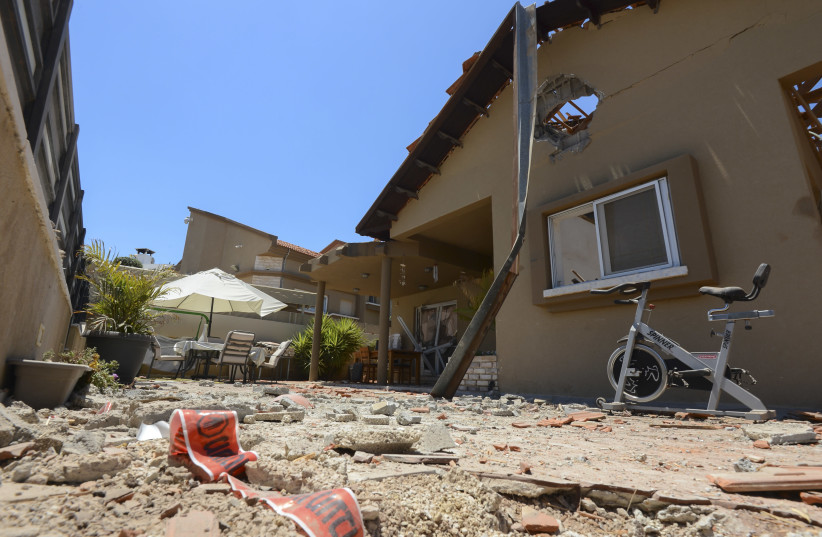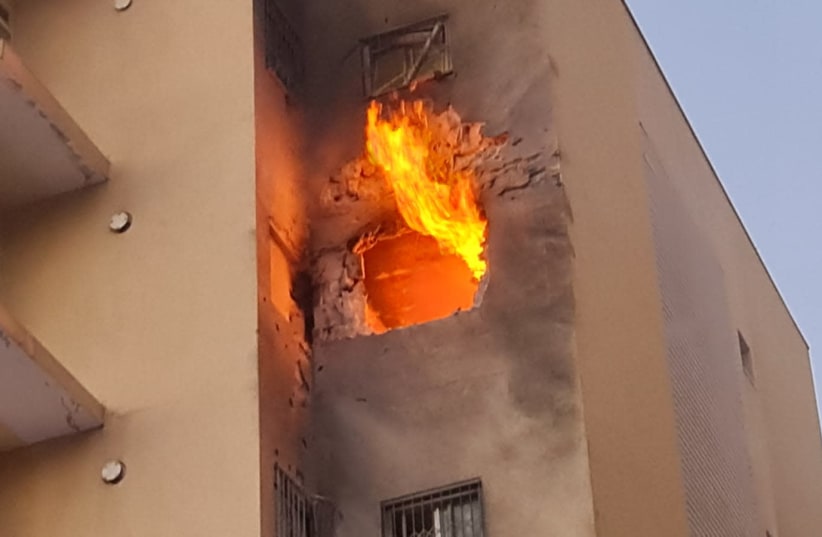Private homes within seven kilometers of the Gaza Strip will not have their bomb-shelter windows replaced with thicker steel shutters, The Jerusalem Post has learned. Due to operational and budgetary considerations, only multistory buildings in Sderot will have their bomb-shelter windows replaced.
The project, which Yediot Aharonot reported will cost an estimated NIS 57 million, follows a military intelligence report following Operation Guardian of the Walls that found terrorist groups in the coastal enclave are in possession of rockets with new capabilities.
IDF Home Front Command initially had recommended that windows in bomb shelters in all communities within seven kilometers of the Gaza Strip be replaced, but the Defense Ministry decided the work only will be done on residential buildings that have more than three floors.
The steel shutters of many bomb-shelter windows are only 16 mm. thick, as current regulations do not demand more, but standard bomb-shelter window shutters are 24 mm. thick.
The new regulations require the shutters to be 32 mm. thick.


The decision to only refit the windows in apartment buildings in Sderot was made following operational considerations “that cannot be specified,” the Post was told. Nevertheless, this has not been done for a long time, and the Defense Ministry was investing millions of shekels into the project, the source said.
“As part of Operation Guardian of the Walls, Home Front Command has been working to upgrade the standard [bomb shelter] windows in the Gaza envelope and recommended starting a project to adjust and thicken the window shutters in this sector and prioritized the city of Sderot according to the characteristics posed by the threat,” the IDF said.
Last September, the Post was told there are some 17,000 bomb shelters within seven kilometers of the Gaza Strip, and of those, an estimated 8,000 windows would need to be replaced at a cost of NIS 60m.
Had all the 17,000 windows been replaced, it would have cost an estimated NIS 119m.
Civilian companies that make the windows have been given the new regulation and have met with officers from Home Front Command so they can replace the windows properly should they be approached by individuals who chose to fund the work on their own.
One window would cost an estimated NIS 5,000 to NIS 7,000.
The recommendation was made following a secondary investigation into the death of six-year-old Ido Avigail, who was killed when a piece of shrapnel penetrated the window of the bomb shelter where he and his family were sheltering from a rocket attack during the 11 days of fighting in May.
Avigail was killed on May 12 during a barrage of rockets targeting Sderot, border communities and the Tel Aviv area. He was one of 12 Israeli civilians killed by rocket fire. One soldier was killed by an anti-tank guided missile.
Then-IDF spokesman Brig.-Gen. (res.) Hidai Zilberman said at the time the incident was the result of an “incredibly rare” convergence of events.
“It was a piece of the rocket that came in at a very specific angle, at a very specific speed and at a very specific point,” he said, adding that the window plating had been constructed properly.
Following the conflict, during which Hamas and Palestinian Islamic Jihad fired more than 4,000 rockets and mortars at Israel, the IDF recognized that despite the Iron Dome missile-defense system, rocket barrages are an area of weakness for the military.
It was the first decision to have been made retroactively and was done “to ensure the safety of the citizens of Israel in accordance with the threats posed,” the IDF said at the time.
Unless this is only the first stage of upgrading windows in the area, residents will begin to put pressure on lawmakers, said Adele Raemer, who lives in Kibbutz Nirim, which was one of the communities that would have had their windows replaced.
When the government first started building bomb shelters, it began with homes along the border and then widened it to communities farther away, she told the Post.
“I’m trying to stay calm, and this is only the first stage,” Raemer said. “I realize that high-rise buildings in Sderot are more in sight of Gaza and would be more sensitive and susceptible to rocket fire... that’s what I’m hoping for.”
If not, she said, “We won’t be quiet... we will wake up our citizen groups and start putting pressure on this decision, because we are on the frontline and we deserve to be protected.”Sources in the Defense Ministry said the decision was also based on financial constraints, and only multistory buildings in Sderot would have their windows refitted.
“Of course it’s because of the money,” Raemer said.
She said the situation reminded her of a visit by former Labor MK Nachman Shai, currently the diaspora affairs minister, who said her bomb shelter would keep her safe from the weapons the groups in the Gaza Strip had at the time.
“They keep developing, they aren’t staying still, and here we are,” Raemer said. “We see that there is a defect in the windows, the most vulnerable part of the bomb shelter. I expect my country to keep me safe.”
She said she feels safe in her bomb shelter, but she is nervous when “rockets are exploding around me. But in each round, the amount of rocket fire rises exponentially.”
“People ask me why do I stay here, and I say, ‘Where should I go?’ How much can you run? This is our home. If everyone in the frontline leaves, then the frontline just moves closer to Tel Aviv. We are here, and we aren’t going anywhere. We are important, and we deserve to be protected and live here safely,” Raemer said.
Since 2006, the government has invested some NIS 1.7 billion ($485m.) in protective facilities in the South around the Gaza Strip where some 46,000 residents live, spending an estimated NIS 37,000 ($10,600) per resident.
In January, the Defense Ministry said it would build new shelters for about 30 daycare centers in Sderot and communities in the Gaza Strip periphery.
Troops from Home Front Command and the Engineering and Construction Division have mapped daycares in the communities, and the work will begin “in the near future in cooperation with the authorities,” the Defense Ministry said in a statement.
The project to build the shelters in the South is the first since 2017.
